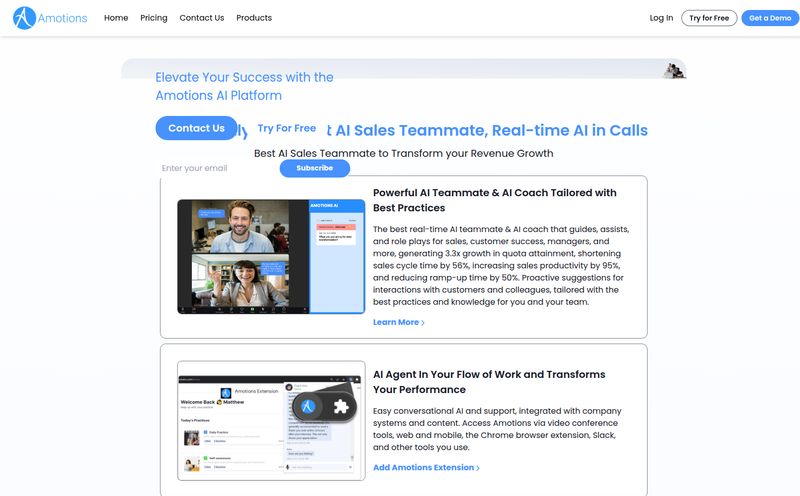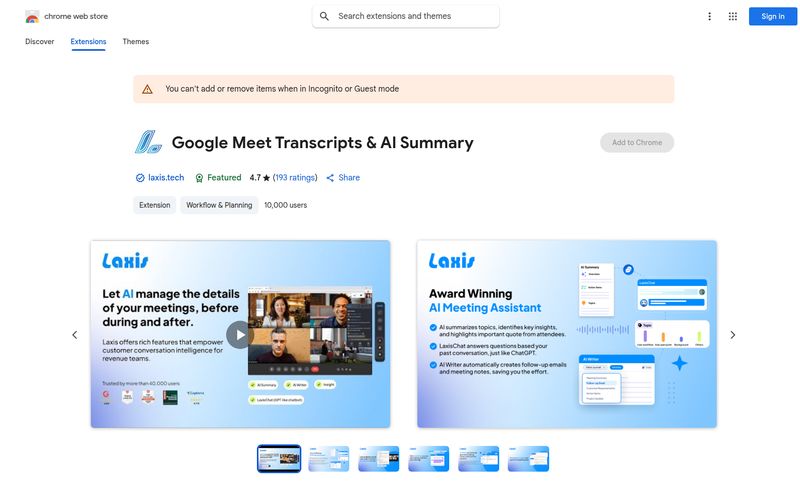Ever feel like you're chasing a ghost in the machine? You're on the hunt for the perfect LLM solution for your company. You read the blogs, you sit through the demos, you follow the links... and you end up at a dead end. A digital '404 Page not found'. It's a feeling I've gotten used to in the AI space. Everyone's selling the dream of intelligent, all-knowing AI, but when you try to apply it to your own specific, messy, real-world data, the dream often evaporates.
You’re left with an AI that confidently makes things up (we call that 'hallucinating'), costs a fortune to run, and knows absolutely nothing about the nuances of your business. It's frustrating. It's the reason so many AI projects are quietly shelved after the initial hype dies down.
So, when I stumbled upon a platform called Lamini, I was skeptical. Another miracle cure for our LLM woes? But the more I looked, the more it seemed like Lamini wasn't just another page on the hype train. It felt... different. Grounded. Built for the people who actually have to make this stuff work. So let’s talk about it.

Visit Lamini
So, What is Lamini, Really?
Let's cut through the jargon. Lamini is an enterprise LLM platform. Think of it less like a pre-trained genius you rent (like ChatGPT) and more like a workshop and a rulebook for building your own specialized genius. It’s designed for software teams who want to take a powerful, general-purpose Large Language Model and train it to become an expert on their specific domain, using their own private data.
The whole point is control. Instead of sending your sensitive data out to a third-party API and hoping for the best, Lamini lets you build your AI within your own digital walls. You can run it on-premise, in your own virtual private cloud (VPC), or even in a completely air-gapped environment. For any company that takes data security seriously, that’s a massive deal.
The Features That Actually Matter
A feature list is just a list. What matters is what those features solve. And Lamini seems laser-focused on solving the biggest headaches in applied AI right now.
Slaying the Hallucination Dragon
This is the big one. LLMs have a nasty habit of just... making stuff up. They'll cite fake sources, invent product features, or give you confidently wrong information. It’s the single biggest barrier to using them for mission-critical tasks. Lamini claims to reduce these hallucinations by up to 95%. How? By combining a few clever techniques, including their 'Memory RAG' (Retrieval-Augmented Generation) and rigorous fine-tuning. It essentially teaches the model to stick to the facts it's been given from your documents, providing citations so you can actually check its work. This isn't just a feature; it's a foundation for building trust in your AI.
Your Data, Your Rules: Fine-Tuning and Security
The real magic of AI for business happens when it understands your business. Lamini is built around the idea of fine-tuning models on your proprietary documents. This means you can create an LLM that knows your internal knowledge base, your product specs, or your customer support history inside and out. It allows you to build smaller, more efficient models that are experts in one thing, rather than a jack-of-all-trades that’s master of none. The fact that you can do this securely, without your data ever leaving your control, is the main event for any CTO or security officer.
Building Specialized AI Agents That Do Real Work
Beyond just question-and-answer, Lamini provides toolkits to build agents that perform tasks. Their Text-to-SQL agent is a fantastic example. Instead of a business analyst needing to learn complex SQL to query a database, they could just ask in plain English, “What were our total sales in the Midwest region last quarter?” and the Lamini-powered agent translates that into a proper database query and gets the answer. This kind of specialized, functional AI is where the real ROI is, and Lamini gives you the tools to build it.
The Upside: Why I'm Genuinely Interested
Honestly, I'm a bit jaded when it comes to AI platforms, but a few things about Lamini stand out. The drastic reduction in hallucinations is obviously the headline. If that 95% claim holds up in real-world use, it's a game-changer. Period.
I also love the focus on efficiency—building smaller, faster LLMs. The industry trend has been “bigger is better,” leading to monstrously expensive models. Lamini pushes back on that, suggesting a smarter, more focused approach is better than a bigger one. This saves on engineering time and compute costs, which makes the CFO happy.
And here’s an interesting little detail for the hardware nerds: Lamini is one of the only platforms optimized to run LLMs on AMD GPUs. In a world completely dominated by NVIDIA's hardware, this is a breath of fresh air. It provides an alternative and potentially more cost-effective hardware path for scaling your AI infrastructure. It's a bold, slightly contrarian move, and I respect it.
The Catch: Let's Talk Drawbacks
No tool is perfect, right? From my perspective, there are a few potential bumps in the road. First, the pricing for their 'Reserved' and 'Self-managed' tiers isn't public. You have to “Contact Us,” which is pretty standard for enterprise software but always feels a bit opaque. I get why they do it, but I prefer upfront costs.
Second, while they're aiming this at software teams, you'll likely need some machine learning expertise on board to really get the most out of the platform. This isn’t a no-code, drag-and-drop solution for your marketing intern. It’s a powerful toolset for developers, and with great power comes a bit of a learning curve.
Finally, that AMD GPU strength could also be a weakness for some. If your organization is already heavily invested in an NVIDIA-based ecosystem, integrating Lamini might require some extra thought on the infrastructure side.
How Much Does Lamini Cost? A Look at the Price Tag
So what's the damage? Lamini actually has a pretty accessible entry point, which is great to see. They've broken their pricing into three main tiers.
| Plan | Model | Best For |
|---|---|---|
| On-demand | Pay-as-you-go. $0.50 per 1M tokens for inference, $0.50 per step for tuning. New users get $300 in free credits. | Teams getting started, prototyping, and running smaller-scale applications. |
| Reserved | Custom pricing. You get dedicated GPUs from Lamini's cluster with unlimited tuning and inference. | Businesses with predictable, high-volume workloads that need guaranteed performance and capacity. |
| Self-managed | Custom pricing. You run Lamini in your own secure environment and pay for a software license. | Large enterprises with strict data residency, security, or compliance requirements (e.g., finance, healthcare). |
The 'On-demand' plan with the $300 credit is a fantastic way to kick the tires without a huge commitment. It's a smart move that lowers the barrier to entry significantly.
Frequently Asked Questions about Lamini
What's the single biggest advantage of using Lamini?
In my opinion, it's the focus on reducing hallucinations. Creating a reliable, trustworthy AI that uses your company's data without making things up is the primary goal, and Lamini is built from the ground up to address this.
Can I use Lamini if I don't have a PhD in machine learning?
It's designed for software teams, so you need to be comfortable with code. However, it handles a lot of the complex ML infrastructure for you. You don't need to be a top-tier AI researcher, but having some familiarity with ML concepts will definitely help you move faster.
Is Lamini secure enough for our sensitive enterprise data?
Yes, security is a core part of its design. The 'Self-managed' option, in particular, allows you to run the entire platform on your own infrastructure, even air-gapped from the internet, giving you maximum control over your data.
How is this different from just using the OpenAI API?
Using a general API like OpenAI's is like renting a car. It's quick and easy, but you can't modify the engine. Lamini is like having your own garage and expert mechanic. It gives you the tools to build and fine-tune a custom vehicle (your LLM) that's perfectly suited for your specific race (your business problem).
What's the deal with the AMD GPUs?
Most of the AI world runs on expensive and often scarce NVIDIA GPUs. By offering first-class support for AMD GPUs, Lamini provides a competitive, alternative hardware path that could lead to better availability and potentially lower costs at scale.
Do they offer a free trial?
Sort of! New users on their 'On-demand' plan get $300 in free credits, which is more than enough to do some serious testing, fine-tune a model, and evaluate if it's the right fit for your project.
My Final Take: No More 'Page Not Found'
Circling back to where we started, the search for the right AI tool can feel like you're lost in a digital labyrinth, constantly hitting that '404 Page not found' wall. Lamini feels like a well-lit path. It isn't trying to be the most magical, all-powerful AI in the universe. Instead, its focused on being a practical, controllable, and secure platform for building LLMs that do real, valuable work.
It’s not a one-click solution, and it's not for everyone. But for a software team that needs to build a specialized AI on its own data without the nonsense—and without the hallucinations—Lamini might just be the page you’ve been looking for all along.



